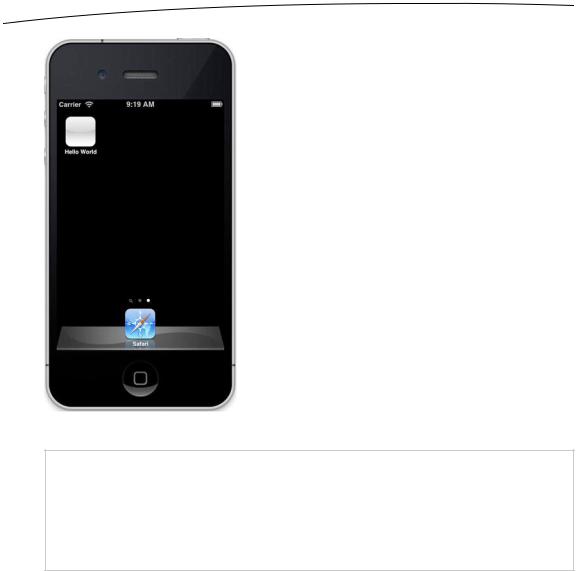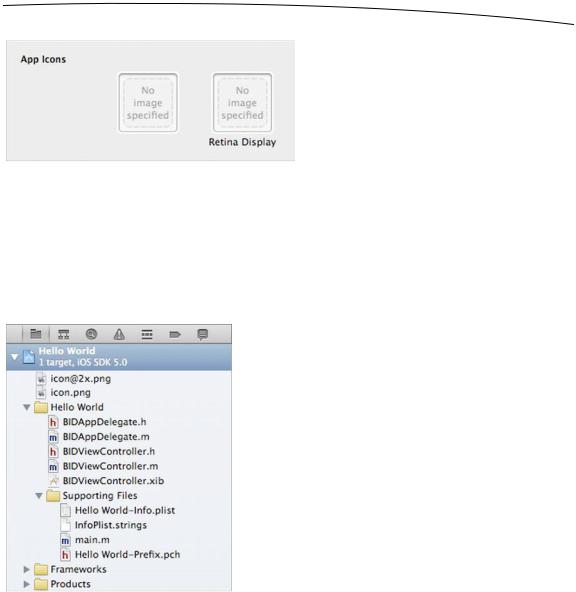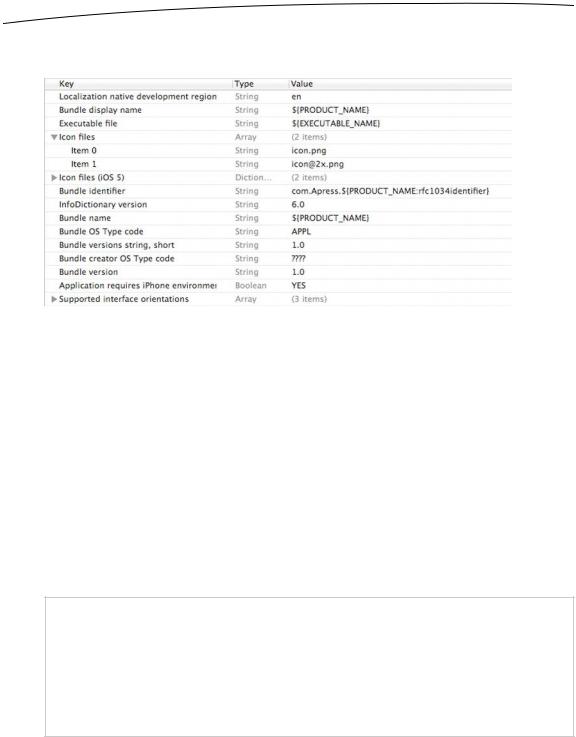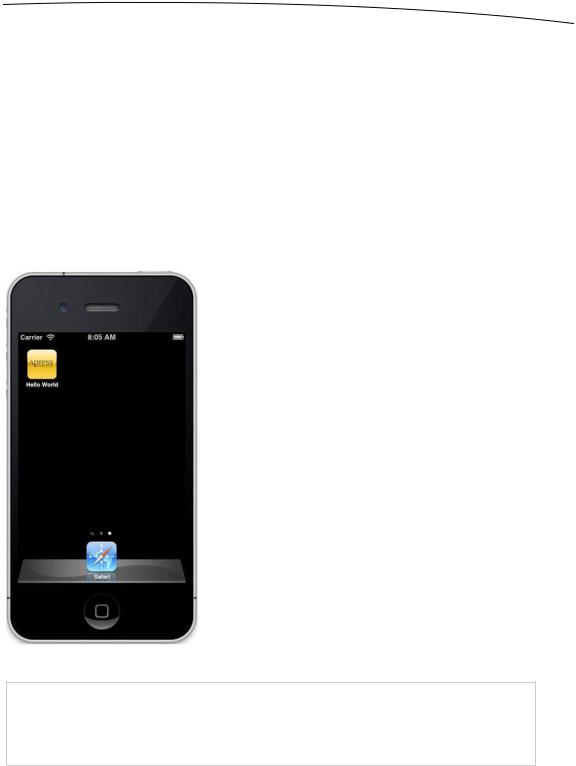
- •Contents at a Glance
- •About the Authors
- •About the Technical Reviewer
- •Acknowledgments
- •Preface
- •What This Book Is
- •What You Need
- •Developer Options
- •What You Need to Know
- •What’s Different About Coding for iOS?
- •Only One Active Application
- •Only One Window
- •Limited Access
- •Limited Response Time
- •Limited Screen Size
- •Limited System Resources
- •No Garbage Collection, but…
- •Some New Stuff
- •A Different Approach
- •What’s in This Book
- •What’s New in This Update?
- •Are You Ready?
- •Setting Up Your Project in Xcode
- •The Xcode Workspace Window
- •The Toolbar
- •The Navigator View
- •The Jump Bar
- •The Utility Pane
- •Interface Builder
- •New Compiler and Debugger
- •A Closer Look at Our Project
- •Introducing Xcode’s Interface Builder
- •What’s in the Nib File?
- •The Library
- •Adding a Label to the View
- •Changing Attributes
- •Some iPhone Polish—Finishing Touches
- •Bring It on Home
- •The Model-View-Controller Paradigm
- •Creating Our Project
- •Looking at the View Controller
- •Understanding Outlets and Actions
- •Outlets
- •Actions
- •Cleaning Up the View Controller
- •Designing the User Interface
- •Adding the Buttons and Action Method
- •Adding the Label and Outlet
- •Writing the Action Method
- •Trying It Out
- •Looking at the Application Delegate
- •Bring It on Home
- •A Screen Full of Controls
- •Active, Static, and Passive Controls
- •Creating the Application
- •Implementing the Image View and Text Fields
- •Adding the Image View
- •Resizing the Image View
- •Setting View Attributes
- •The Mode Attribute
- •Interaction Checkboxes
- •The Alpha Value
- •Background
- •Drawing Checkboxes
- •Stretching
- •Adding the Text Fields
- •Text Field Inspector Settings
- •Setting the Attributes for the Second Text Field
- •Creating and Connecting Outlets
- •Closing the Keyboard
- •Closing the Keyboard When Done Is Tapped
- •Touching the Background to Close the Keyboard
- •Adding the Slider and Label
- •Creating and Connecting the Actions and Outlets
- •Implementing the Action Method
- •Adding Two Labeled Switches
- •Connecting and Creating Outlets and Actions
- •Implementing the Switch Actions
- •Adding the Button
- •Connecting and Creating the Button Outlets and Actions
- •Implementing the Segmented Control Action
- •Implementing the Action Sheet and Alert
- •Conforming to the Action Sheet Delegate Method
- •Showing the Action Sheet
- •Spiffing Up the Button
- •Using the viewDidLoad Method
- •Control States
- •Stretchable Images
- •Crossing the Finish Line
- •The Mechanics of Autorotation
- •Points, Pixels, and the Retina Display
- •Autorotation Approaches
- •Handling Rotation Using Autosize Attributes
- •Configuring Supported Orientations
- •Specifying Rotation Support
- •Designing an Interface with Autosize Attributes
- •Using the Size Inspector’s Autosize Attributes
- •Setting the Buttons’ Autosize Attributes
- •Restructuring a View When Rotated
- •Creating and Connecting Outlets
- •Moving the Buttons on Rotation
- •Swapping Views
- •Designing the Two Views
- •Implementing the Swap
- •Changing Outlet Collections
- •Rotating Out of Here
- •Common Types of Multiview Apps
- •The Architecture of a Multiview Application
- •The Root Controller
- •Anatomy of a Content View
- •Building View Switcher
- •Creating Our View Controller and Nib Files
- •Modifying the App Delegate
- •Modifying BIDSwitchViewController.h
- •Adding a View Controller
- •Building a View with a Toolbar
- •Writing the Root View Controller
- •Implementing the Content Views
- •Animating the Transition
- •Switching Off
- •The Pickers Application
- •Delegates and Data Sources
- •Setting Up the Tab Bar Framework
- •Creating the Files
- •Adding the Root View Controller
- •Creating TabBarController.xib
- •The Initial Test Run
- •Implementing the Date Picker
- •Implementing the Single-Component Picker
- •Declaring Outlets and Actions
- •Building the View
- •Implementing the Controller As a Data Source and Delegate
- •Implementing a Multicomponent Picker
- •Declaring Outlets and Actions
- •Building the View
- •Implementing the Controller
- •Implementing Dependent Components
- •Creating a Simple Game with a Custom Picker
- •Writing the Controller Header File
- •Building the View
- •Adding Image Resources
- •Implementing the Controller
- •The spin Method
- •The viewDidLoad Method
- •Final Details
- •Linking in the Audio Toolbox Framework
- •Final Spin
- •Table View Basics
- •Table Views and Table View Cells
- •Grouped and Plain Tables
- •Implementing a Simple Table
- •Designing the View
- •Writing the Controller
- •Adding an Image
- •Using Table View Cell Styles
- •Setting the Indent Level
- •Handling Row Selection
- •Changing the Font Size and Row Height
- •Customizing Table View Cells
- •Adding Subviews to the Table View Cell
- •Creating a UITableViewCell Subclass
- •Adding New Cells
- •Implementing the Controller’s Code
- •Loading a UITableViewCell from a Nib
- •Designing the Table View Cell in Interface Builder
- •Using the New Table View Cell
- •Grouped and Indexed Sections
- •Building the View
- •Importing the Data
- •Implementing the Controller
- •Adding an Index
- •Implementing a Search Bar
- •Rethinking the Design
- •A Deep Mutable Copy
- •Updating the Controller Header File
- •Modifying the View
- •Modifying the Controller Implementation
- •Copying Data from allNames
- •Implementing the Search
- •Changes to viewDidLoad
- •Changes to Data Source Methods
- •Adding a Table View Delegate Method
- •Adding Search Bar Delegate Methods
- •Adding a Magnifying Glass to the Index
- •Adding the Special Value to the Keys Array
- •Suppressing the Section Header
- •Telling the Table View What to Do
- •Putting It All on the Table
- •Navigation Controller Basics
- •Stacky Goodness
- •A Stack of Controllers
- •Nav, a Hierarchical Application in Six Parts
- •Meet the Subcontrollers
- •The Disclosure Button View
- •The Checklist View
- •The Rows Control View
- •The Movable Rows View
- •The Deletable Rows View
- •The Editable Detail View
- •The Nav Application’s Skeleton
- •Creating the Top-Level View Controller
- •Setting Up the Navigation Controller
- •Adding the Images to the Project
- •First Subcontroller: The Disclosure Button View
- •Creating the Detail View
- •Modifying the Disclosure Button Controller
- •Adding a Disclosure Button Controller Instance
- •Second Subcontroller: The Checklist
- •Creating the Checklist View
- •Adding a Checklist Controller Instance
- •Third Subcontroller: Controls on Table Rows
- •Creating the Row Controls View
- •Adding a Rows Control Controller Instance
- •Fourth Subcontroller: Movable Rows
- •Creating the Movable Row View
- •Adding a Move Me Controller Instance
- •Fifth Subcontroller: Deletable Rows
- •Creating the Deletable Rows View
- •Adding a Delete Me Controller Instance
- •Sixth Subcontroller: An Editable Detail Pane
- •Creating the Data Model Object
- •Creating the Detail View List Controller
- •Creating the Detail View Controller
- •Adding an Editable Detail View Controller Instance
- •But There’s One More Thing. . .
- •Breaking the Tape
- •Creating a Simple Storyboard
- •Dynamic Prototype Cells
- •Dynamic Table Content, Storyboard-Style
- •Editing Prototype Cells
- •Good Old Table View Data Source
- •Will It Load?
- •Static Cells
- •Going Static
- •So Long, Good Old Table View Data Source
- •You Say Segue, I Say Segue
- •Creating Segue Navigator
- •Filling the Blank Slate
- •First Transition
- •A Slightly More Useful Task List
- •Viewing Task Details
- •Make More Segues, Please
- •Passing a Task from the List
- •Handling Task Details
- •Passing Back Details
- •Making the List Receive the Details
- •If Only We Could End with a Smooth Transition
- •Split Views and Popovers
- •Creating a SplitView Project
- •The Storyboard Defines the Structure
- •The Code Defines the Functionality
- •The App Delegate
- •The Master View Controller
- •The Detail View Controller
- •Here Come the Presidents
- •Creating Your Own Popover
- •iPad Wrap-Up
- •Getting to Know Your Settings Bundle
- •The AppSettings Application
- •Creating the Project
- •Working with the Settings Bundle
- •Adding a Settings Bundle to Our Project
- •Setting Up the Property List
- •Adding a Text Field Setting
- •Adding an Application Icon
- •Adding a Secure Text Field Setting
- •Adding a Multivalue Field
- •Adding a Toggle Switch Setting
- •Adding the Slider Setting
- •Adding Icons to the Settings Bundle
- •Adding a Child Settings View
- •Reading Settings in Our Application
- •Retrieving User Settings
- •Creating the Main View
- •Updating the Main View Controller
- •Registering Default Values
- •Changing Defaults from Our Application
- •Keeping It Real
- •Beam Me Up, Scotty
- •Your Application’s Sandbox
- •Getting the Documents Directory
- •Getting the tmp Directory
- •File-Saving Strategies
- •Single-File Persistence
- •Multiple-File Persistence
- •Using Property Lists
- •Property List Serialization
- •The First Version of the Persistence Application
- •Creating the Persistence Project
- •Designing the Persistence Application View
- •Editing the Persistence Classes
- •Archiving Model Objects
- •Conforming to NSCoding
- •Implementing NSCopying
- •Archiving and Unarchiving Data Objects
- •The Archiving Application
- •Implementing the BIDFourLines Class
- •Implementing the BIDViewController Class
- •Using iOS’s Embedded SQLite3
- •Creating or Opening the Database
- •Using Bind Variables
- •The SQLite3 Application
- •Linking to the SQLite3 Library
- •Modifying the Persistence View Controller
- •Using Core Data
- •Entities and Managed Objects
- •Key-Value Coding
- •Putting It All in Context
- •Creating New Managed Objects
- •Retrieving Managed Objects
- •The Core Data Application
- •Designing the Data Model
- •Creating the Persistence View and Controller
- •Persistence Rewarded
- •Managing Document Storage with UIDocument
- •Building TinyPix
- •Creating BIDTinyPixDocument
- •Code Master
- •Initial Storyboarding
- •Creating BIDTinyPixView
- •Storyboard Detailing
- •Adding iCloud Support
- •Creating a Provisioning Profile
- •Enabling iCloud Entitlements
- •How to Query
- •Save Where?
- •Storing Preferences on iCloud
- •What We Didn’t Cover
- •Grand Central Dispatch
- •Introducing SlowWorker
- •Threading Basics
- •Units of Work
- •GCD: Low-Level Queueing
- •Becoming a Blockhead
- •Improving SlowWorker
- •Don’t Forget That Main Thread
- •Giving Some Feedback
- •Concurrent Blocks
- •Background Processing
- •Application Life Cycle
- •State-Change Notifications
- •Creating State Lab
- •Exploring Execution States
- •Making Use of Execution State Changes
- •Handling the Inactive State
- •Handling the Background State
- •Removing Resources When Entering the Background
- •Saving State When Entering the Background
- •A Brief Journey to Yesteryear
- •Back to the Background
- •Requesting More Backgrounding Time
- •Grand Central Dispatch, Over and Out
- •Two Views of a Graphical World
- •The Quartz 2D Approach to Drawing
- •Quartz 2D’s Graphics Contexts
- •The Coordinate System
- •Specifying Colors
- •A Bit of Color Theory for Your iOS Device’s Display
- •Other Color Models
- •Color Convenience Methods
- •Drawing Images in Context
- •Drawing Shapes: Polygons, Lines, and Curves
- •The QuartzFun Application
- •Setting Up the QuartzFun Application
- •Creating a Random Color
- •Defining Application Constants
- •Implementing the QuartzFunView Skeleton
- •Creating and Connecting Outlets and Actions
- •Implementing the Action Methods
- •Adding Quartz 2D Drawing Code
- •Drawing the Line
- •Drawing the Rectangle and Ellipse
- •Drawing the Image
- •Optimizing the QuartzFun Application
- •The GLFun Application
- •Setting Up the GLFun Application
- •Creating BIDGLFunView
- •Updating BIDViewController
- •Updating the Nib
- •Finishing GLFun
- •Drawing to a Close
- •Multitouch Terminology
- •The Responder Chain
- •Responding to Events
- •Forwarding an Event: Keeping the Responder Chain Alive
- •The Multitouch Architecture
- •The Four Touch Notification Methods
- •The TouchExplorer Application
- •The Swipes Application
- •Automatic Gesture Recognition
- •Implementing Multiple Swipes
- •Detecting Multiple Taps
- •Detecting Pinches
- •Defining Custom Gestures
- •The CheckPlease Application
- •The CheckPlease Touch Methods
- •Garçon? Check, Please!
- •The Location Manager
- •Setting the Desired Accuracy
- •Setting the Distance Filter
- •Starting the Location Manager
- •Using the Location Manager Wisely
- •The Location Manager Delegate
- •Getting Location Updates
- •Getting Latitude and Longitude Using CLLocation
- •Error Notifications
- •Trying Out Core Location
- •Updating Location Manager
- •Determining Distance Traveled
- •Wherever You Go, There You Are
- •Accelerometer Physics
- •Don’t Forget Rotation
- •Core Motion and the Motion Manager
- •Event-Based Motion
- •Proactive Motion Access
- •Accelerometer Results
- •Detecting Shakes
- •Baked-In Shaking
- •Shake and Break
- •Accelerometer As Directional Controller
- •Rolling Marbles
- •Writing the Ball View
- •Calculating Ball Movement
- •Rolling On
- •Using the Image Picker and UIImagePickerController
- •Implementing the Image Picker Controller Delegate
- •Road Testing the Camera and Library
- •Designing the Interface
- •Implementing the Camera View Controller
- •It’s a Snap!
- •Localization Architecture
- •Strings Files
- •What’s in a Strings File?
- •The Localized String Macro
- •Real-World iOS: Localizing Your Application
- •Setting Up LocalizeMe
- •Trying Out LocalizeMe
- •Localizing the Nib
- •Localizing an Image
- •Generating and Localizing a Strings File
- •Localizing the App Display Name
- •Auf Wiedersehen
- •Apple’s Documentation
- •Mailing Lists
- •Discussion Forums
- •Web Sites
- •Blogs
- •Conferences
- •Follow the Authors
- •Farewell
- •Index

CHAPTER 2: Appeasing the Tiki Gods |
39 |
playing, save the file and select Run again. The changes you made should show up in your application, once again without writing any code.
NOTE: Don’t worry too much about what all of the fields in the object attributes inspector mean,
or fret if you can’t get one of your changes to show up. As you make your way through the book,
you’ll learn a lot about the object attributes inspector and what each of the fields does.
By letting you design your interface graphically, Interface Builder frees you to spend time writing the code that is specific to your application, instead of writing tedious code to construct your user interface.
Most modern application development environments have some tool that lets you build your user interface graphically. One distinction between Interface Builder and many of these other tools is that Interface Builder does not generate any code that must be maintained. Instead, Interface Builder creates Objective-C objects, just as you would do in your own code, and then serializes those objects into the nib file so that they can be loaded directly into memory at runtime. This avoids many of the problems associated with code generation and is, overall, a more powerful approach.
Some iPhone Polish—Finishing Touches
Now let’s put a last bit of spit and polish on our application to make it feel a little more like an authentic iPhone application. First, run your project. When the simulator window appears, click the iPhone’s home button (the black button with the white square at the very bottom of the window). That will bring you back to the iPhone home screen, as shown in Figure 2–20. Notice anything a bit, well, boring?
Take a look at the Hello World icon at the top of the screen. Yeah, that icon will never do, will it? To fix it, you need to create an icon and save it as a portable network graphic (.png) file. Actually, you should create two icons. One needs to be 114 × 114 pixels in size, and the other needs to be 57 × 57 pixels. Why two icons? Well, the iPhone 4 introduced the Retina display, which was exactly double the resolution of earlier iPhone models. The smaller icon will be used on non-Retina devices, and the larger one will be used on devices with a Retina display.
Do not try to match the style of the buttons that are already on the phone when you create the icons; your iPhone will automatically round the edges and give it that nice, glassy appearance. Just create normal flat, square images. We have provided two icon images in the project archive 02 - Hello World folder, called icon.png and icon@2x.png, which you can use if you don’t want to create your own. The @2x in the name of the larger file is a special naming convention that identifies the file as the Retina version of the same file with the same name minus the @2x.
www.it-ebooks.info

40 |
CHAPTER 2: Appeasing the Tiki Gods |
Figure 2–20. Our Hello, World icon is just plain boring. It needs a real icon!
NOTE: For your application’s icon, you must use .png images, but you should actually use that format for all images in your iOS projects. Xcode automatically optimizes .png images at build time, which makes them the fastest and most efficient image type for use in iOS apps. Even though most common image formats will display correctly, you should use .png files unless you
have a compelling reason to use another format.
After you’ve designed your app icon, press 1 to open the project navigator, and then click the topmost row in the navigator—the one with the blue icon and the name Hello World. Now, turn your attention to the editing pane.
On the left side of the editing pane, you’ll see a white column with list entries labeled PROJECT and TARGETS. Make sure that the Hello World target is selected. To the right of that column, you’ll see a big, gray settings pane. At the top of that pane is a series of five tabs. Select the Summary tab. In the Summary tab, scroll down, looking for a section labeled App Icons (see Figure 2–21). This is where we’ll drag our newly added icons.
www.it-ebooks.info

CHAPTER 2: Appeasing the Tiki Gods |
41 |
Figure 2–21. The App Icon boxes on your project’s Summary tab. This is where you can set your application’s icon.
From the Finder, drag icon.png to the left rectangle. This will copy icon.png into your project and set it as your application’s icon. Next, drag icon@2x.png from the Finder to the right rectangle, which will set that as you application’s Retina display icon.
If you look back in the project navigator, you’ll notice that the two images were added to your project, but not inside a folder (see Figure 2–22). To keep our project organized, select icon.png and icon@2x.png, and drag them to the Supporting Files group.
Figure 2–22. When the icons are added to your project, they’re not placed in a subfolder. If you want to keep your project organized, you’ll need to move them yourself.
Let’s take a look at what Xcode did with those icons, behind the scenes. In Xcode’s project navigator, look in the Supporting Files folder again, and then single-click the Hello_World-Info.plist file. This is a property list file that contains some general information about our application, including specifics on our project icon files.
When you select Hello_World-Info.plist, the property list will appear in the editor pane. Within the property list, find a row with the label Icon files in the left column. The corresponding right column in that same row should say (2 items). This row holds an array, which means it can hold multiple values. In this case, there’s one row for each
www.it-ebooks.info

42 |
CHAPTER 2: Appeasing the Tiki Gods |
icon that was specified. Single-click the disclosure triangle immediately to the left of the name Icon Files, and you’ll see the two items in the array, as shown in Figure 2–23.
Figure 2–23. Expanding the disclosure triangle shows the contents of the Icon Files array. Inside the array, you’ll find a row for each of our two icon files.
Looking at the plist contents in Figure 2–23, you might notice another row with the key Icon Files (iOS 5). If you click the disclosure triangle next to that entry, you’ll see that it contains two named entries: one called Primary Icon and another called Newsstand Icon. If you expand Primary Icon, you’ll see the same thing you saw under Icon Files. Don’t be too concerned about this. If you set your icons using Xcode the way we just did, Xcode will always configure the property list correctly.
The reason that the same icon information is represented twice is that prior to iOS 5, there was only one icon for an app, so a single array (Icon Files) was sufficient for holding the information about the icons. With iOS 5, Apple introduced a way to specify other types of icons for your application, including one to be used within Apple’s Newsstand app. We won’t be covering Newsstand in this book, so you don’t need to worry about when or why you would specify an icon for that. Just be aware that iOS 5 introduced a new way to specify icons, and for the time being, apps will be supporting both the old and new methods.
NOTE: If you were to just copy the two icon image files into your Xcode project and do nothing else, your icon would actually show up anyway. Huh? Why’s that? By default, if no icon file name
is provided, the SDK looks for a resource named icon.png and uses that. You also don’t need to tell it about the @2x version of the icon. iOS knows to look for that on a device with a Retina display. To be safe, however, you should future-proof your app and always specify your
application’s icons in the info property list.
Now, take a look at the other rows in Hello_World-Info.plist. While most of these settings are fine as they are, one in particular deserves a moment of our attention: Bundle
www.it-ebooks.info

CHAPTER 2: Appeasing the Tiki Gods |
43 |
identifier. This is that unique identifier we entered when we created our project. This value should always be set. The standard naming convention for bundle identifiers is to use one of the top-level Internet domains, such as com or org followed by a period, then the name of your company or organization followed by another period, and finally, the name of your application.
When we created this project, we were prompted for a bundle identifier, and we entered com.apress. The value at the end of the string is a special code that will be replaced with your application’s name when your application is built. This allows you to tie your application’s bundle identifier to its name. If you need to change your application’s unique identifier after creating the project, this is where you would do it.
Now compile and run your app. When the simulator has finished launching, press the button with the white square to go home, and check out your snazzy new icon. Ours is shown in Figure 2–24.
Figure 2–24. Your application now has a snazzy icon!
NOTE: If you want to clear out old applications from the iPhone simulator’s home screen, you can choose iPhone Simulator Reset Content and Settings…. from the iPhone simulator’s
application menu.
www.it-ebooks.info
